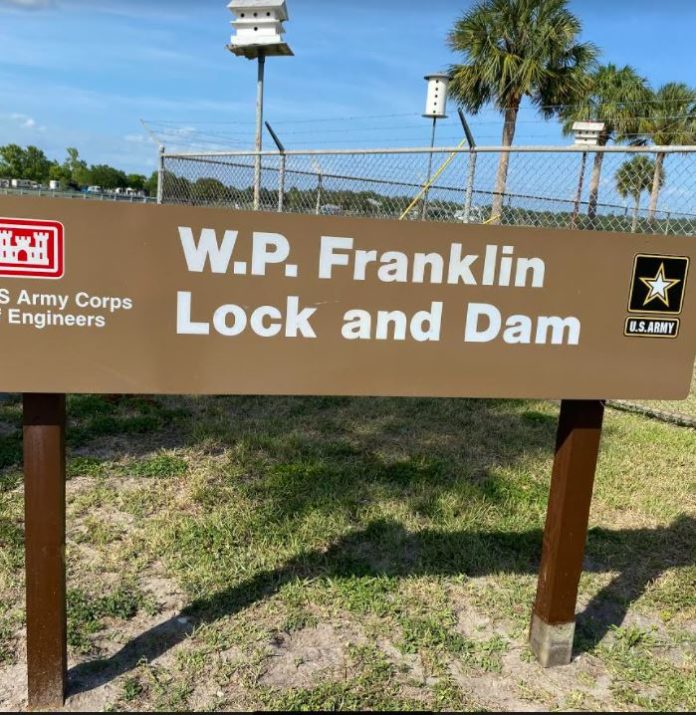(By Kim Ryan) I recently stopped by the W.P. Franklin South US Army Corp of Engineers Day Use Area which is located in Alva on the south bank of the Caloosahatchee River to scope it out for a possible spot to run. What I saw and smelled had me running in the opposite direction.
On one side of the walkway, which extends out to the locks, you could easily spot the blue green slime accumulating in clumps near the water’s edge stuck in the vegetation. The smell was beyond obnoxious and no mask was going to diminish the assault to the olfactory sense. On the other side less visible but still present was a green haze slowly drifting down the river.
Not all algal blooms are harmful. Algae which are plant-like organisms that sustain marine life contribute to the food chain and to the oxygen that keeps water bodies healthy. However, when conditions are right like warm weather or an abundance of nutrients and stagnant water conditions they bloom and grow.
Some of these become HAB’s, or Harmful Algal blooms, which can release toxins such is the case with the Blue Green Algae flowing down from Lake Okeechobee. In Florida, we find HABs along our saltwater, freshwater and brackish water bodies.
How harmful these toxins can be is still being researched but according to the Florida Fish and Wildlife Conservation Commission “Cyanobacteria and their toxins can disrupt and damage sensitive ecosystems, and threaten public and natural resources health and the environment.”
In water bodies with blue-green algae, if people or animals splash or if boats create wakes, the cyanotoxins in the algae can release into the air. The toxins mix with water droplets and spray—that’s how people and animals can inhale the toxin. These toxins can’t pass through your skin easily so swallowing large amounts of contaminated water is what causes illness. According to the CDC’s Cyanobacteria bloom F.A.Q. sheet: “Cyanotoxins are among the most powerful natural poisons known.”
In addition to freshwater algae blooms fed by phosphorus, there are also salt water blooms like the naturally occurring Red Tide which can become enormous when fed by nitrogen nutrients which are found in, among other things, fertilizer. Here in our area we have to deal with both. According to NOAA, “The HABs in fresh and marine waters are usually very different, but they overlap in low salinity estuaries (places where rivers meet the sea).”
So what happens when river meets ocean, fresh meets salty? According to an interview with FGCU’s Dr. Mike Parsons back in 2018 on Beach Talk Radio, “Discharges do not directly cause Red Tide which naturally occurs. The red tide has to be there before anything can influence it.”
What Parsons said is echoed by research in the Mote Marine Laboratory and Aquarium Annual Report which stated that “nutrients recycled from dying blue-green algae in the lower river could have provided some nutrients to red tide cells at the river mouth, but not enough to be the main fuel source for this bloom.”
In a recent report on WINK-TV, SCCF Executive Director Jamie Evan said, “We have the same concerns this year, that the blue-green algae that comes from Lake Okeechobee could feed the Red Tide bloom that we already have here in Southwest Florida.”
Jacqui Thurlow-Lippisch, who was appointed to the South Florida Water Management District in 2019, stated in a 2018 post on her website that this putrid, polluted water runs out into the ocean. “We think that’s the end of the water destruction, but it’s not, as red tide and seaweed are fertilized, growing into monsters we have never seen before, they are hungry and determined and we are feeding them.”
What can be done?
According to Kevin Claridge, Vice President of Sponsored Research and Coastal Policy Programs, at MOTE, we can stop dumping nutrients into the waters that feed into our bays, harbors and the Gulf of Mexico, which many believe can help feed the organism and trigger harmful blooms. “We have a couple of big players to the north and south that may exacerbate the situation: to the north, we saw millions of gallons of contaminated water spill from Piney Point near Port Manatee in the south portion of Tampa Bay, and to the south there are continuing releases of high-nutrient freshwater and blue-green algae down the Caloosahatchee River from Lake Okeechobee”
And you can stay actively involved. Lee County Commissioner Brian Hamman recently urged citizens to email the Army Corps of Engineers at LakeOComments@usace.army.mil. Hamman says residents need to ask the Corps to decrease high-volume discharges and increase optimal flows. “We cannot continue to be starved for water in the dry season only to be deluged by high volume discharges weeks later as the rainy season arrives … Clearly we are at a point where they simply view Lee County taxpayers as a revenue source and a place to put their dirty water, and that’s it.”


Comments are closed.